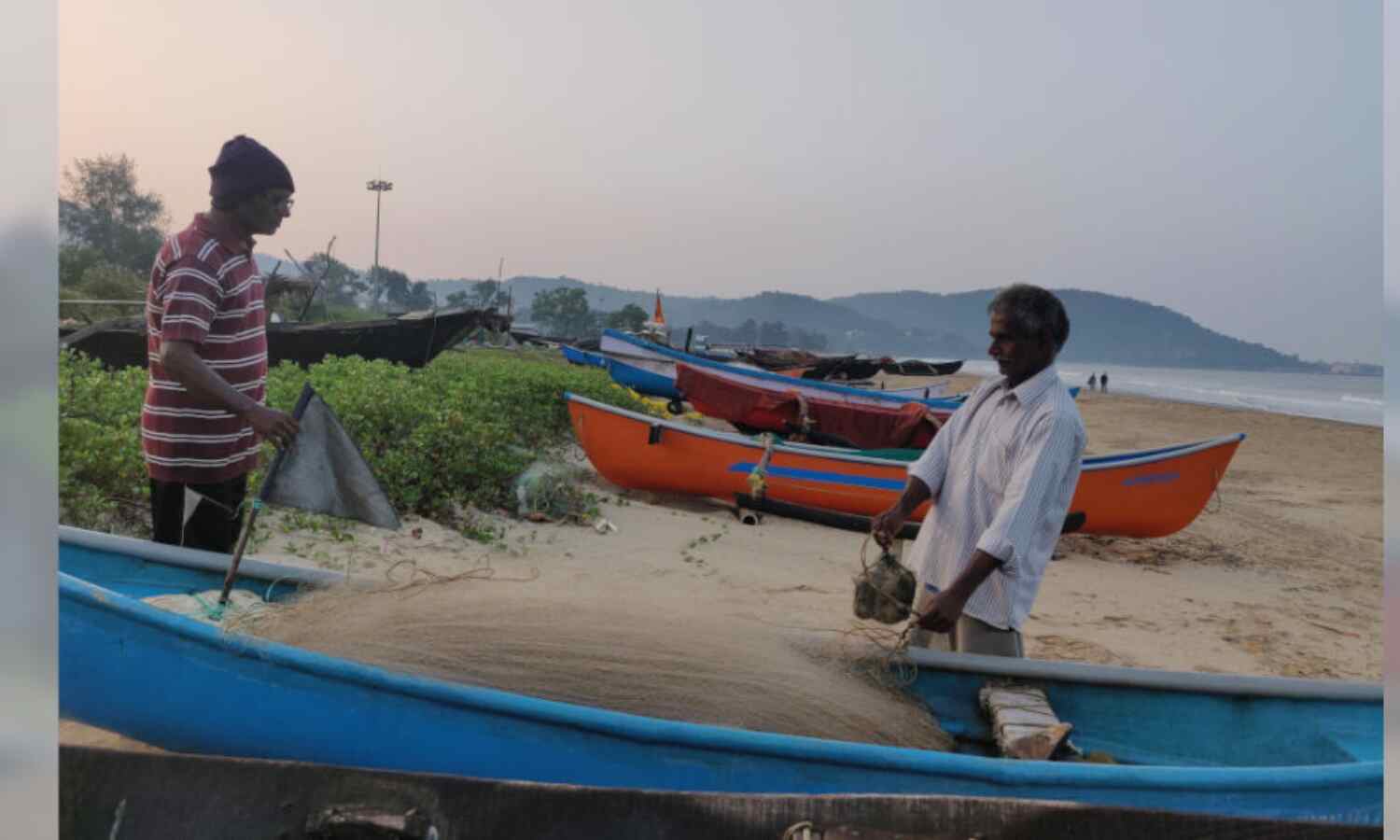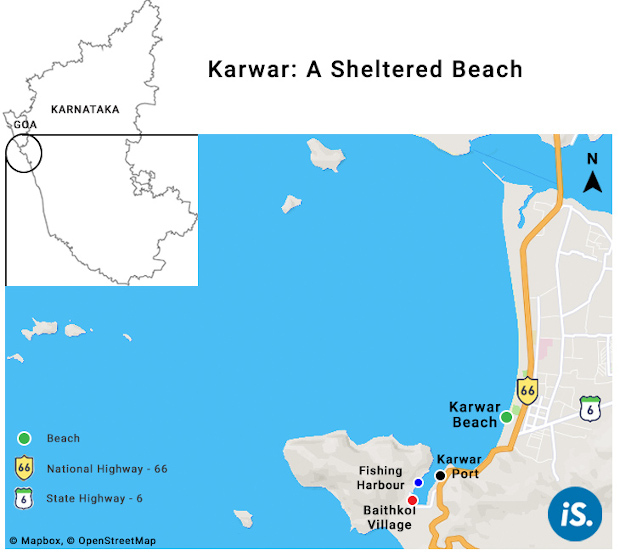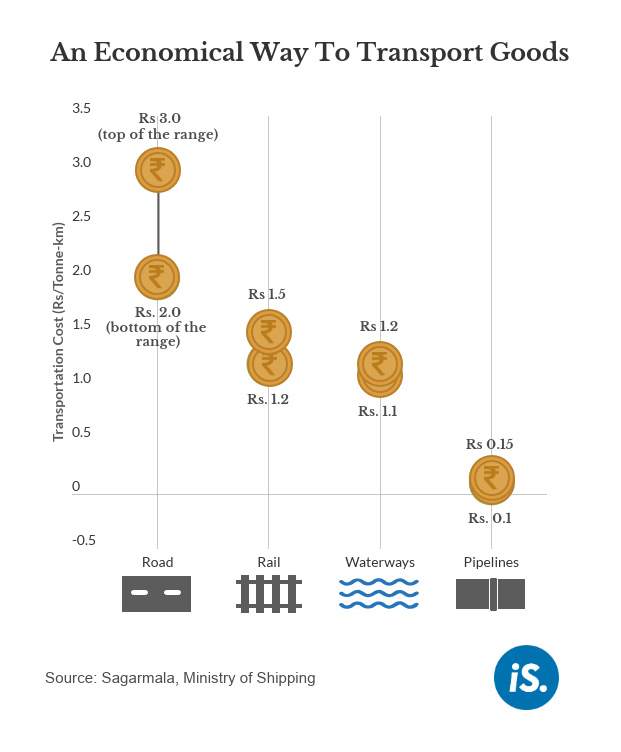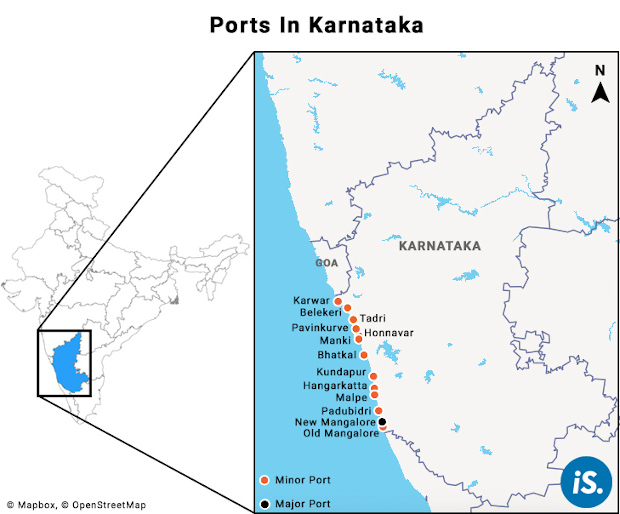As Karwar's Port Expansion Threatens Jobs & Fisheries, Fisherfolk Question 'Development'


This series was produced in partnership with the Pulitzer Center. The story contains footnotes marked with asterisks
Karwar and Bengaluru: Less than 100 km south of Goa, Karwar is a scenic town in coastal Karnataka along India's western coast. In the wee hours of the morning, when the temperature is balmy and the fresh air leaves a mixture of salt and sand on the skin, fisherfolk dot the 3-km pristine beach lining the town's western side. They stand next to their anchored boats, untangling fishing nets after the end of early morning labour.
Around 10,000 fisherfolk depend upon the Karwar fishing harbour at the southern end of the beach, according to estimates by local community leaders. And Karwar is the perfect place for the job. The beach here is what scientists call a "sheltered
"The small islands surrounding this beach make it a bay with plenty of catch," said local marine biologist Prakash Mesta.
Next to the fishing harbour stands the 28-year-old natural, all-weather Karwar port. The commercial port is set to be expanded at a cost of Rs 1,993.54 crore ($298 million) under the Ministry of Shipping's port modernisation and development programme, Sagarmala. The Rs 6.01 lakh crore ($79 billion) programme, which began in 2015, has identified 574 projects across India. New ports will be built and old ones, such as the one in Karwar, will be expanded.
After the expansion, Karwar port's annual capacity to handle cargo is expected to increase from the current 3 million tonnes (MT) to 4.5 MT, according to project documents. The port expansion can lead to an increase in air pollution, risks oil spills in the water, and may permanently alter the land around the port, the documents show.
The Karwar port currently occupies three hectares of land, roughly the size of five football fields, according to this January 2020 Karnataka High Court order on a petition that sought to bring the expansion to a halt. The expansion is approved on another 17 hectares, according to project documents, or nearly six times as much land as it now stands on, and will encroach on the adjacent fishing village of Baithkol, home to over 6,000 fisherfolk, according to local leaders' estimates.
Among them is Sadanand Malshekar, a slightly built man who speaks softly. The 62-year-old told IndiaSpend that he learnt fishing from his father as a teenager. This is what he has been doing for over four decades now. He stopped work for over a week to protest the Karwar port's expansion in January 2020. The expansion, put on hold by the Karnataka High Court (HC) shortly after the protests, threatens the only way of livelihood he knows.
India's coastal regulation zone
In recent years, the right to grant permissions for most projects along the coastline has been delegated to the state governments; there is no central database where states reveal how many CRZ projects they have approved on their respective coasts. India's Ministry of Environment, Forest and Climate Change (MoEFCC) has given environment clearances
What makes the expansion of Karwar port stand out is that Karwar's coastline was designated as one of India's 13 Critically Vulnerable Coastal Areas (CVCA) in order to protect the "critical coastal environment", according to the central government's January 2019 CRZ notification. This designation meant no new project or expansion of old projects were to be permitted here. At the same time, local communities were to be involved in managing the coastline, a recommendation that the Karnataka state government disregarded 11 months later, in December 2019, when it approved the port expansion, the HC's January 2020 order shows.
It will take 21 years, in the best case scenario, before the Karwar port will have enough traffic to utilise the new infrastructure it is putting in place, as per official documents examining the environmental impact of the port expansion project; "flexibility" to improve the project's viability has therefore been recommended.
IndiaSpend reached out to Devendra Kumar Rai, the director of the Sagarmala project, to understand the need for the expansion of the Karwar port. We will update this report when we receive a response.
Port-related and other construction activity on Karwar beach have caused considerable damage to the beach ecosystem in Karwar, the HC's order cited above shows. "The dredging activity in the port has already led to a decline in the fish catch in the past few years," said CPR's Patgar.
IndiaSpend reached out to Prasanna Patgar, deputy conservator of forests and regional director (environment) for Karwar region, who is responsible for granting CRZ clearances. This report will be updated if and when he responds on why the port expansion project in a CVCA was approved.
The story of Karwar port's expansion is one that highlights the debate between the need for conservation and economic activity. It is also a story of local jobs coming under threat and of local communities getting disempowered in favour of projects considered beneficial for the nation's growth.
This is the fourth of a multi-part, data-driven series, Environment Undone, which explores the environmental, ecological and human cost of India's chosen path of development. You can read part one here, two here and three here.

Source: Ministry of Environment, Forest & Climate Change
Port: An economic need
Around 95% of India's merchandise trade by volume passes through sea ports, according to government data. In terms of cost, transporting goods through waterways is more economical than doing so by roads or railways.

India plans to invest Rs 100 lakh crore ($1.3 trillion) over the five years to 2025-26 to develop roads, including 2,000 km of coastal and land port roads, Finance Minister Nirmala Sitharaman announced in the budget for the year 2020-21. These roads will connect ports to major cities and mining areas, facilitating transport of resources and goods.
India currently has 12 large and 205 small functional and non-functional ports. "Cargo traffic at major ports in the country was reported to be 699.05 MT for financial year 2018-19, even as cargo traffic handled stood at 585.72 MT (until January 2020 for 2019-20)," said Gayathri Iyer, junior fellow, strategic studies, Observer Research Foundation.
"It is important for India to invest in its maritime infrastructure to be able to attract direct port calls to its shores," Iyer told IndiaSpend, "and not be vulnerable to geopolitical risks emerging from Chinese investments in Colombo's Hambantota mega-port and Pakistan's Gwadar mega-port."
The Sagarmala programme is "aimed at accelerating economic development in the country by harnessing the potential of India's coastline and river network," according to the central government's Sagarmala National Perspective Plan. It is estimated that the programme will create 4 million jobs.
Under the programme, 48 port projects are planned to come up in Karnataka at an estimated cost of Rs 24,772 crore ($3.2 billion), Nitin Gadkari, Union transport minister who also oversees the shipping ministry, had announced in March 2018. These, Gadkari had said, would include projects to modernise existing ports, improve connectivity and develop coastal areas.
Karnataka's 300-km coastline has one major port, the New Mangalore Port, and 12 minor ports. This means the state has one port every 23 km, on average. Of these, Karwar is the only all-weather port.

Source: Department of Ports & IWT of the Government of Karnataka
The sheltering effect of the coastline that makes the Karwar harbour ideal for fisherfolk is also the reason why this area is ideal for a port, according to project documents. When the waters along India's western coastline get choppy during the monsoon months (June - September), the sheltering effect of the Karwar coastline helps ships stabilise as well as navigate.
Industry observers like Iyer say that emphasis should not just be on building new ports, but on increasing capacity of existing ports in green ways. This is a sentiment echoed by the Karwar port authorities as well; they believe the expansion at Karwar is in line with the larger vision of Sagarmala.
"This [Karwar] port mainly caters to northern Karnataka," Captain C Swamy, director of Ports & Inland Water Transport (IWT), Karwar, told IndiaSpend. "It is strategically located. Since there is no expansion here [to handle additional cargo], most of the cargo of Uttara Karnataka goes to the New Mangalore Port [to the south] or the state of Goa [to the north]."
Karwar port will need more breakwaters and jetties to accommodate more ships, said Swamy. "The depth now is 8.5 m. We will have to deepen it to 14 m so that bigger ships can dock at the port."
A legal framework gone wrong
The legal framework for development along India's coastline goes back nearly three decades to 1991. To construct any permanent structure, permissions are needed from the government. Some permissions are given by the central and others by the state governments depending on the kind of project being proposed.
A series of dilutions to this notification over subsequent years opened up India's coastline to unprecedented development at the cost of livelihoods of those like Malshekar, and to the detriment of fragile coastlines that it was meant to protect.
"CRZ 1991 went through eight reviews and over 20 amendments and became a document that was difficult to read and understand," said Meenakshi Kapoor, an independent environmental policy researcher.
In 2011, led by then environment minister Jairam Ramesh, it was replaced by a new notification. "CRZ 2011 was an attempt to compile the changes in one document and re-examine the dilutions to bring the focus back to the protection of coastal environment and livelihoods," said Kapoor.
Fisherfolks' rights to live on the coastline was recognised after consultations with fishing communities. Within years, another set of changes began to take place.
A month after Prime Minister Narendra Modi's National Democratic Alliance (NDA) government came to power in May 2014, a new committee--formed during the previous United Progressive Alliance term--under Shailesh Nayak, then the secretary of the Ministry of Earth Sciences, was asked to address concerns of the state governments. The Nayak committee--officially known as the 'Committee to review issues relating to the coastal regulation zone notification 2011'--recognised that while the CRZ notification sought to balance the conservation needs with economic ones, state officials were burdened with the task of approvals. This left them with little time and bandwidth for conservation activities. It also highlighted that states need to do the basics first, which is to map their coastlines, before they focus on the task of approving projects.
This highlighted a crucial gap: States in charge of giving permissions to build along the coastline were doing so without adequate data on where their critical ecosystems were.
Nayak told IndiaSpend that the main purpose of the CRZ policy was conservation, and that his committee attempted to bring back the focus on ecological areas. "We placed a lot of emphasis in preparing the coastal zone management plans (CZMP)," said Nayak. "Unless the plans are made, and these plans show that this is what we are going to do [for conservation], nothing [no project] would be permitted."
To balance the economic needs of a country of 1.3 billion, the Nayak committee recommended that the coast be opened to more tourism, but with a rider. It recommended that the locals be roped in to do this themselves so that they reap the economic benefits.
Some of the Nayak committee's recommendations were incorporated in the CRZ 2018 notification even as other changes were introduced. This new CRZ notification was approved in January 2019.
Among the changes that the 2019 CRZ notification introduced is that in densely populated rural areas (CRZ-III A), the Protected Area
The government has also opened up the beach to temporary tourism facilities such as shacks, changing rooms and drinking water facilities, not just for the locals but for anyone seeking to do so. For other activities, one needs an EC--relatively easy to obtain, as reported in part one of this series--from the central or state government, depending on the category of the project.
Observers say the new framework is vague and moves away from conservation. "Words like 'strategic purpose' and 'public utilities' have been used [in the 2019 CRZ notification] to imply that while there are prohibitions, exceptions can be made," Kapoor told IndiaSpend. These words are currently undefined and can be used to justify any activity, she said.
Local destruction, national interest
The consequences of such justification are at play in Karwar. The port expansion is set to cause permanent damage to the land-use pattern

The Karwar port (pictured above) is at the southern end of the narrow beach. Apart from a new cargo terminal, new structures such as breakwaters on the beach and the expansion of roads leading to the port, are proposed to be built. These could severely disturb fishing activity in the area.
The construction of breakwater
Sea walls and other hard structures have a history of leading to beach erosion, as observed in Pondicherry on India's east coast and other parts of Karwar where IndiaSpend reported from in November 2018.
"Breakwaters were responsible for causing beach erosion at Ullal (Mangalore)," said K.T. Tandel, 75, a leader from the fishing community. "We want the government to let the [Karwar] port be the way it is."
Mesta, the marine biologist, hails from the fishing community. He points out that extensive coastal erosion along the north Karnataka coastline is affecting residents, who find themselves unable to cope. "Traditional fisherfolk and those with homes along the coast are the worst-affected when the coastline is eroded," he said. If the port expansion further threatens the coastline, then they will be the worst-hit, he added. "They neither have the money to switch to mechanical boats, nor the resources to rebuild their homes away from the coast."
The Karnataka HC--approached by the local group Baithkol Bandharu Nirashrithara Yanrikrut Dhoni Meenugarara Sahakara Sangha Niyamitha against the Karnataka Maritime Board in 2020--called out Karwar port authorities' "high-handedness" for progressing with the expansion without a clearance from the state pollution control authorities.
The National Highway (NH)-66, outside the Karwar beach, is also being expanded. Some of the debris has been dumped on the beachfront. An estimated 80 kg/day construction waste and another 145 kg/day municipal solid waste is expected to be generated during the expansion of the port and the road.

Breakwaters, part of Karwar port expansion work, have been constructed by dumping rocks on the beach. Experts point to the futility of building such structures here because Karwar is a sheltered beach, meaning the wave speed is already reduced by its surrounding islands.
"What we started was preliminary work," said Capt Swamy, a reasoning also provided to the HC. "A lot of boulders were required [for port expansion] and there must be an approach road to reach the site. So, that preliminary work was started."
Fisherfolk fear that the dredging and construction activity due to the port expansion work will pollute the water and make it unfit for fishing. "The port already gets in the way of fishing, but we manage. [The authorities ought to] Let us fisherfolk be," said Tandel, the local leader.
Tandel's fear of the port expansion's impact on livelihoods is not unfounded. In Goa, there has been a precedent of local communities around Mormugao port being affected as pollution soared due to coal handling at the port. The Karwar port is currently used to transport 3 MT of commodities, including petroleum products, and when the proposed expansion is complete, it will load and unload highly polluting coal and iron-ore, according to project documents.
"All infrastructure, whether it is for the nation, for the states, or for the city, serves particular publics," Nikhil Anand, an environmental anthropologist with an interest in infrastructure studies, told IndiaSpend. Anand, a professor at the University of Pennsylvania, added, "Infrastructure redistributes resources. It is always about redistribution."
Areas categorised as CVCA are to be developed with the participation of local communities. In Karwar, the port expansion appears to be alienating the locals in favour of national interest.
The threat from climate change
The expansion comes at a time when coastal ecosystems are under stress due to rising global carbon emissions. Oceans suck up as much as 25% of the carbon dioxide released in the air, causing them to warm.
The record pace of warming has meant that marine heatwaves
Closer home, the Bay of Bengal, the Indian Ocean and the Arabian Sea are all showing signs of change. "The largest impact (of sea-level rise) is along the Indian Ocean rim countries, small islands where we have a bellying population and in vulnerable low-lying land," said Roxy Mathew Koll, a climate scientist at the Indian Institute of Tropical Meteorology.
The Arabian Sea, along India's west coast where Karwar is, has enjoyed a relatively stable climate over centuries but the warming of the planet is set to change this, as IndiaSpend reported in December 2019.
"The twin problems are that the Arabian Sea is becoming warmer and it has a permanent oxygen minimum zone (dead zone), which is expanding," said Joaquim Goes, a research professor at the Lamont-Doherty Earth Observatory under Columbia University. This dead zone has so little oxygen that there is almost no life there.
"The Arabian Sea has reached a point where it's showing signs that it's gasping for breath," Goes told IndiaSpend. "You see signs of this from time to time all along the west coast... sardines coming to the shore in massive numbers trying to escape from this low-oxygen waters."
Fisheries and aquaculture provide employment to over 14 million people in India, according to the National Fisheries Development Board (NFDB). India's deep seas are home to 10% of global biodiversity in terms of fish and shellfish species, according to government data. The country's total fish production was estimated to be 12.6 million metric tonne in 2017-18, or 6.3% of the global fish production, as per NFDB data.
"Our database indicates that fisheries in India host close to 1,200 species, of which more than 700 species are caught every year," said Grinson George, senior scientist at the Central Marine Fisheries Research Institute. While it is normal for fish catch to fluctuate year-on-year, "climate change is definitely affecting the fisheries, particularly the pelagic fishery

Fishing activities in Karwar face the dual threat of climate change and infrastructure projects.
Dwindling fish catch, other hiccups
In Karwar, the fisherfolk do not understand the science but feel the impact. "Our fish catch has dwindled," said Shridhar Harikantra, who lives in the Baithkol fishing village next to the Karwar fishing harbour. "Some fish species, such as sardines, have disappeared altogether in the last 2-3 years."
Reduced income from fishing is beginning to impact the fisherfolk's lives. Harikantra said that fishermen are struggling to repay money they had borrowed from banks to buy mechanised boats, yet others have had their homes, offered as collateral for loans of upto Rs 3 lakh, seized.
The fisherfolk add that the state of fish stock in the Arabian Sea is so dire that those from neighbouring Maharashtra and Goa come as far south as Karwar. They attribute this decline in catch to a combination of climate change and mismanagement.
With the expansion of the Karwar port, Harikantra and others worry about the increased pressure this would put on fishing activities.
Project documents record that 92.12% of those living in the Baithkol village are "industrial workers, teachers and government officials". This is a claim residents like Harikantra scoff at; Baithkol is locally known as a fishing village, and even the well-educated are pushed to join the fishing and allied industry because there are no other jobs.
Not acknowledging the costs to potentially affected communities is often intentional, say experts, as it allows project proponents to show, on paper, that the costs are lower than the benefit. "Not seeing all those relationships that are lost, not just social relationships but even the relationships to the economy, not seeing all those relationships makes it easier for the benefits to be more evident compared to the costs," Anand told IndiaSpend.
For instance, the Karwar port's documents do not account for the allied fishing activity or the trade already happening in the sea, and assumes that the only economic activity in town is the one that happens through large infrastructure projects.
This is not the first time the Karwar coastline has been tampered with. There are remnants of other projects, undertaken over the past decade, with the aim to increase tourism. Residues--sections of tracks and other debris--of an abandoned toy train project litter the beachside. Another undertaking, a garden, for which fertile soil was brought and dumped atop the sand, and walls built to cordon it off from the beach, finds few takers, as IndiaSpend witnessed.
"These walls block the path of the turtles coming to lay their eggs in the sand," said Mesta, the marine biologist. "There is a lot of benthic
When a proposed project's viability is considered, these ecological costs--damage to the coastline, biodiversity loss--are almost impossible to quantify, as we explored in the second report in this series. "While one can attempt a cost-benefit analysis of a project, a monetary value cannot always be attached to a benefit," said Minal Pathak, senior scientist with Ahmedabad University and the Intergovernmental Panel on Climate Change

A garden (on the left) and other structures have been built on the ecologically sensitive Karwar beach. The beach is a nesting ground for local sea turtles as well as the olive ridley turtles, and these structures get in the way, according to local scientists.
Neither jobs, nor ecology
In March 2020, before the country went under a nation-wide lockdown due to COVID-19, India's unemployment rate stood at 8.75%, according to Centre for Monitoring of Indian Economy, a business information company. While unemployment in urban areas was at 9.41%, it was 8.44% in rural areas.
Development or environment, that is a hard choice one has to make, Gadkari told Parliamentarians in the Lok Sabha in August 2019.
But what happens when there is neither, ask the fishermen in Karwar.
The central government's rationale for the Sagarmala programme is simple: The port will bring more jobs and economic growth. The project documents for Karwar port do not specify how many local jobs the expansion will create. The promise of economic growth rings hollow to locals like Malshekar.
Malshekar has a daughter, his only child. Unlike him, she went to college, and holds a master's degree in commerce. "But there are no jobs here," said Malshekar. "So she is at home." And soon, with the port expanded and no sign of local jobs, he fears his earnings might take a hit too.
It's not just the men who will feel the pinch. While they are responsible for the catch, it is the women who sell the fish. Their livelihoods are at stake too.
"No one spoke to us fisherfolk before giving permission to the Sagarmala project," Sushila Harikantra, 65, one of the vocal voices in the fisher community, told IndiaSpend. "Our educated kids do not get jobs elsewhere. Here, with the help of their boats, they make a small living. This project will destroy several families in our communities."
IPCC's Pathak said that the impact of a project on women like Sushila Harikantra is an afterthought for policy makers. "The committees that decide on these projects are often all [staffed with] men," said Pathak while highlighting the need to evaluate the social cost of projects on the lives of a community. "[When] You do not have women participation [in making decisions], so you do not have a good understanding of the impacts the women face."
India has an opportunity to build infrastructure that takes climate change into account. Since India is not yet locked into expensive infrastructure, said Pathak, this is a good opportunity to factor risks while constructing.
Nayak, whose committee looked at the gaps in the CRZ notification in 2015, highlighted that the issue of equity between stakeholders like fishing communities, private players and the government is difficult to address when making policies. "There is no clear answer," he said. "It has to be seen on a case-by-case basis." He added that there is a realisation in the policy circles now, "that if you don't protect the environment, [then] we will be in trouble in the future".
While infrastructure policies might not be designed with the interest of the most marginalised people in mind, according to experts, for fisherfolk like Malshekar, the fight is for survival. "This is where I was born and where I earn a living," he said. "This is where I want to die."
This is the fourth of a five-part series that explores the environmental, ecological and human cost of India's chosen path of development. You can read the first part here, the second here, the third here, and the concluding part here.
(Shetty is an IndiaSpend reporting fellow. Graphics by Jameela Ahmed and Vishal Bhargav. Editing by Marisha Karwa.)
We welcome feedback. Please write to respond@indiaspend.org. We reserve the right to edit responses for language and grammar.


